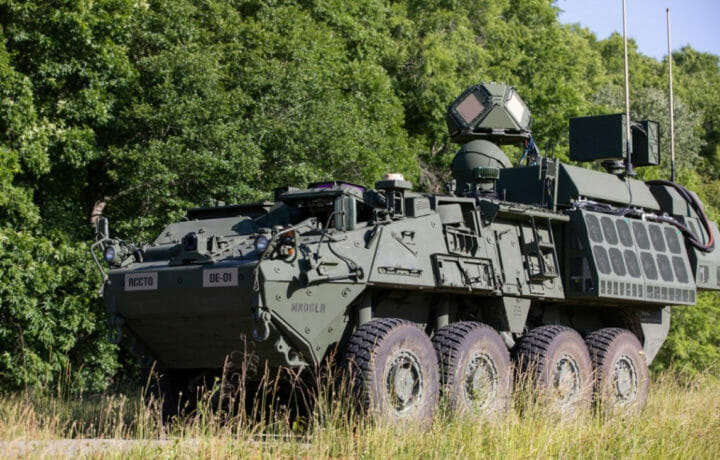Say “laser weapons,” and most people picture sci-fi action movies. But guns that shoot high-powered energy beams instead of bullets are becoming a reality in the U.S. military. The Army, Air Force, and Navy have all been designing and testing High-Energy Laser (HEL) systems, with a few already certified for real-life combat use. According to defense leaders, these futuristic arms hold promising advantages over traditional weapons for taking down enemy artillery, missiles, and aerial drones.
Lasers in the Army
“It’s just a bullet made out of light — that’s the only difference. The kill chain is the same,” said Lt. Gen. Neil Thurgood, head of the U.S. Army’s Rapid Capabilities and Critical Technologies Office (RCCTO), in a recent symposium announcing the upcoming delivery of laser-equipped Stryker armored vehicles to Fort Sill, Oklahoma this September.
Atop each Stryker will be a turret housing a Directed Energy Maneuver Short-Range Air Defense (DE M-SHORAD), a 50-kilowatt HEL capable of shooting down aerial drones as heavy as 1,320 pounds. This laser has also shown effectiveness in field tests at striking down rockets, mortars, and artillery, according to the Army.
Fort Still personnel will put the DE M-SHORAD-equipped Strykers through further rounds of testing over the coming year. Meanwhile, the Army will up its laser game with testing this fall of an even bigger 300-kilowatt laser weapon that fires from the top of an OshKosh Army truck to take down cruise missiles and other large flying targets.
Why Lasers?
“Kinetic” weapons—conventional rifles, cannons, and rocket launchers, which fire solid projectiles at their targets—have been mainstays of combat for centuries and will remain so. But they have their limitations. First, once they fire all their ammunition, they are empty and have to be reloaded. Second, to have enough ammunition on hand for continuous reloads, the military force needs convoys to come resupply them—and those convoys must navigate hostile territory to reach them, risking being captured or killed by the enemy the whole way.
HELs mitigate both problems. One, there is no reloading. Their laser beams are pure energy, and as long as the weapon has a working energy source—i.e., a battery or generator—it can keep on firing.
And with no need for ammo, there won’t need to be as many convoys. Convoys will still have to bring new batteries and, occasionally, more generators. But they can cover this with fewer missions, which is literally a lifesaver for them: fewer casualties from enemy ambushes. And the combat units will be able to move and operate faster, further, and deeper into enemy territory, less encumbered by supply constraints and less weighted down by the heavy cargo of stockpiled ammo.
Lasers are also a potential money saver. Manufacturing enough bullets and other munitions for front-line forces has been a massive, and massively costly, endeavor for modern armies. With lasers reducing the amount of solid munitions needed, the military can reallocate money and labor from munition production to other pressing manufacturing and research-and-development priorities.
Air Force and Navy Lasers
The Air Force has been leading the way on HELs, running laser experiments as far back as the 1980s. In the 1990s, it installed a laser cannon on a converted Boeing 747 jet liner and sent it flying over the Pacific Ocean to try to spot and shoot down enemy ballistic-missile launches.
That laser-equipped Boeing has long since been retired, but a new laser has cleared testing and is now fully operational at a few (undisclosed) Air Force bases. That laser, built by Raytheon, is the High-Energy Laser Weapon System (HELWS). Like the Army’s DE M-SHORAD, the HELWS fits atop ground vehicles and shoots down aerial drones. Its 15-kilowatt infrared beam can take down small- and medium-sized drones (weighing up to 55 pounds max), frying their circuits and killing them on impact.
Meanwhile, 2020 was the year the Navy got its first laser-armed ship. Private contractor VTG installed the Optical Dazzling Interdictor Navy (ODIN) onto a guided-missile destroyer, the USS Preble. Eight more Navy vessels have been outfitted with ODIN lasers since. The laser is another drone-killer, shooting an infrared beam that disables a drone’s sensors, causing it to lose its way and crash into the ocean.
Another Navy laser went into operation this year and has enough power to bring down cruise missiles. The High Energy Integrated Optical Dazzler and Surveillance (HELIOS), developed by Lockheed Martin and installed just this month on the guided-missile destroyer USS Preble, has a 60-kilowatt beam that is strong enough to not just scramble a missile’s navigation coordinates, but actually blow the missile up in mid-air. Navy engineers may soon devise a scaled-up HELIOS for use on aircraft carriers.
Drawbacks of Lasers
Lasers make great weapons, clearly. But they’re not great for every time and place. Like any beam of light, they lose some of their punch when it’s cloudy or rainy. And while their concentrated beams can take down single drones fast, they can be overwhelmed if facing a swarm of many drones—in such cases, backup firepower from conventional guns will be needed. And while they don’t require munitions, they do require electricity, and lots of it. Not every ship, air base, or ground unit will have the generator or battery power to go 100% laser.
U.S. military planners look forward to lasers being a useful addition to the existing kinetic weaponry. But not a replacement for it. The two types of technology can, and probably will, work alongside each other.
Still, lasers give military forces some valuable new options for defending against enemy attacks. Working alongside conventional weapons, they’ll make for a fuller range of protection against a wider range of threats.




